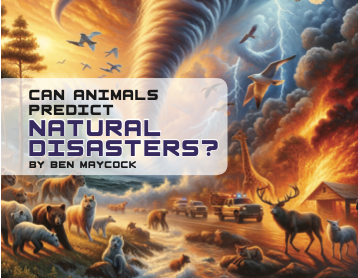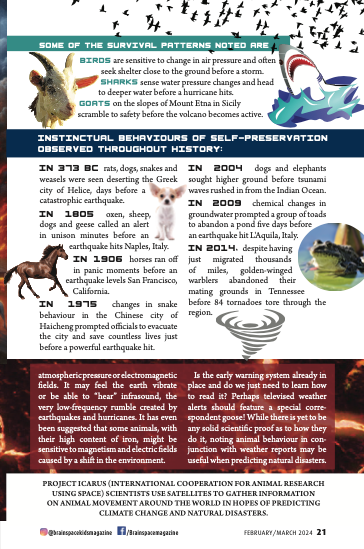
Predicting where, when and how a natural disaster such as an earthquake or tsunami might present itself has been challenging scientists for centuries. Satellites, radar and seismic sensors are all effective ways of measuring an event as it occurs, but they are not infallible when warning us of an impending threat.


Accurate human-made early warning systems may be possible in the future. Until then, could animal behaviour offer us the clues we need to alert people in time for them to get to safety? Science has yet to prove whether or how an animal might sense the approach of a natural disaster, but observations of animal behaviour have made this an interesting theory to investigate.
.
A natural disaster, like a predator, is a threat and an animal’s instinct to survive is its strongest motivation. A change in the environment that signals danger is at hand will prompt it to seek safety. Even slight changes, imperceptible to us, can be sensed through an animal’s highly developed senses.
.
An animal might detect shifts in atmospheric pressure or electromagnetic fields. It may feel the earth vibrate or be able to “hear” infrasound, the very low-frequency rumble created by earthquakes and hurricanes. It has even been suggested that some animals, with their high content of iron, might be sensitive to magnetism and electric fields caused by a shift in the environment.
.
Is the early warning system already in place and do we just need to learn how to read it? Perhaps televised weather alerts should feature a special corre- spondent goose! While there is yet to be any solid scientific proof as to how they do it, noting animal behaviour in con- junction with weather reports may be useful when predicting natural disasters.
PROJECT ICARUS (INTERNATIONAL COOPERATION FOR ANIMAL RESEARCH USING SPACE) SCIENTISTS USE SATELLITES TO GATHER INFORMATION ON ANIMAL MOVEMENT AROUND THE WORLD IN HOPES OF PREDICTING CLIMATE CHANGE AND NATURAL DISASTERS.


